· 5 min read
Intermittent renewables? Lack of energy storage? Where do we expect to source extra energy in times of high demand after we have done away with fossils? A possible answer: Why not build a super-grid?
The Viking Link, developed by Energinet and the British National Grid is a planned 760 km long electricity interconnector between Denmark and the UK (Launch date: 12/2023). Majorly being built in the North Sea, it will involve the construction of converter sites and installation of onshore and offshore cable in each country. These are then connected to the substations in the respective countries.
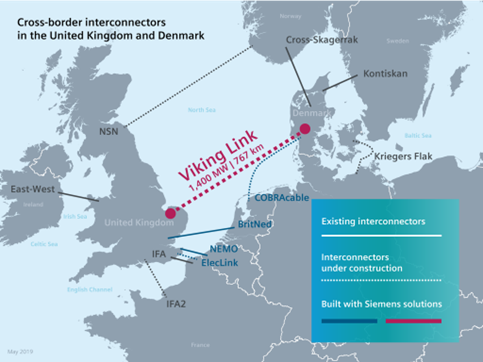
Interconnectors are high voltage DC (HVDC) cables that allow for 2 or more countries to link their electricity systems. They can run under the sea, underground or via overhead cabling unlike natural gas, which is exclusively shared via pipelines or ship. Their main purpose is to move surplus renewable electricity between asynchronous AC transmission systems from where it’s produced to where it’s needed most, thus creating a cross-border interconnected grid of sorts. HVDC also allows transfer of power between grid systems running at different frequencies with minimal losses and increased stability, thus enabling power transfer between incompatible networks.
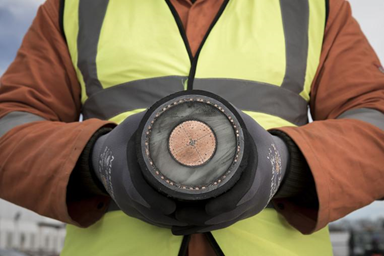
Here are a couple of benefits that play into investing in interconnected grids, as opposed to everyone hoarding their own energy:
- Sharing power: This ensures that more countries invest into renewables without the fear of facing blackouts and rising electricity prices.
- Make Money from excess energy production: better possibilities for cross-border electricity trading will contribute to lower wholesale prices for electricity.
- Ensure there's enough energy in circulation: This ensures the energy security of all the nations involved.
- Bi-directional power flow: Unlike gas pipes, interconnectors allow for energy transfer on an ad-hoc basis from countries with excess generation to those with excess demand.
Pursuant to this idea, lies the concept of a European super grid, a blanket term to define a series of projects taking place in Europe and beyond. It is a possible future super grid that would ultimately interconnect the various European countries and the regions around Europe's borders, such as North Africa and the Middle East. The Super Grid seeks to both improve existing energy interconnectors and create new ones, thus increasing the capacity and quality of power transmission among countries. A super-grid also acts as a large pool, allowing for efficient sharing of power plants and wider use of renewable energies. For example, France which has a large installed capacity of nuclear power (which however is expensive to build) could export its surplus via the interconnectors being built between the countries of Central Europe (cross-border exports already exist). Renewables, and wind resources installed in most European countries can be utilized much more efficiently, as "it is always windy somewhere" – it tends to be windy in the summer in North Africa, and windy in the winter in Europe!
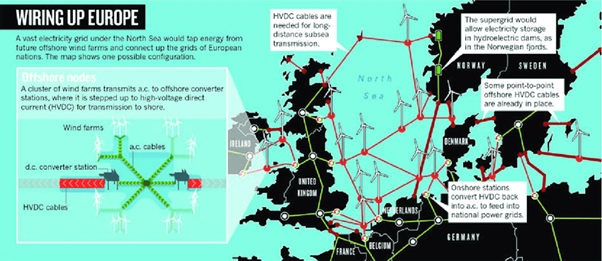
The European super grid also plays a vital role as a part of the EU hoping to achieve climate neutrality by 2050 and is one of the pillars of the European Green Deal legislation. The European Commission aims to achieve 15% of interconnection by 2030. The means that by then each country should possess the appropriate infrastructure to export at least 15% of the electricity produced by its power plants. The super grid also takes into consideration, the disparity between countries in terms energy mix and allows each member to specialize in the types of energy production they find most fruitful.
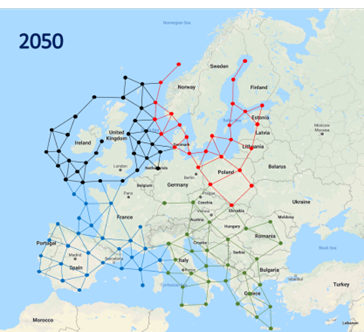
Elsewhere, other major economies are also planning similar megaprojects. The most well known of these is the ‘Green Grids Initiative – One Sun One World One Grid’ (GGI-OSOWOG) launched by India at COP26. Backed by 83 nations (the latest being Oman), this project aspires to lay the foundations for the world’s first transnational solar power grid network, that will help manage global supply and demand by enabling need-based exchange of electricity between the member countries, which notably include Australia, France, Germany, Middle Eastern countries, Nigeria, and the UK. This expands the connectivity potential of the Indian grid, which is already connected with neighbor countries Nepal, Bangladesh, Bhutan, Myanmar, and Sri Lanka. Under the GGI-OSOWOG initiative, the Indian grid can initially be connected to Africa (via Oman), which accounts for 40% of total global horizontal irradiance; but lacks the economic conditions for large scale installation of solar. With proper investment in the international power grid, the solar resources in Africa can be tapped easily, and based on the availability and requirement, power can be transferred to India. On the other hand, when Africa experiences low irradiance, power can be exported from India.
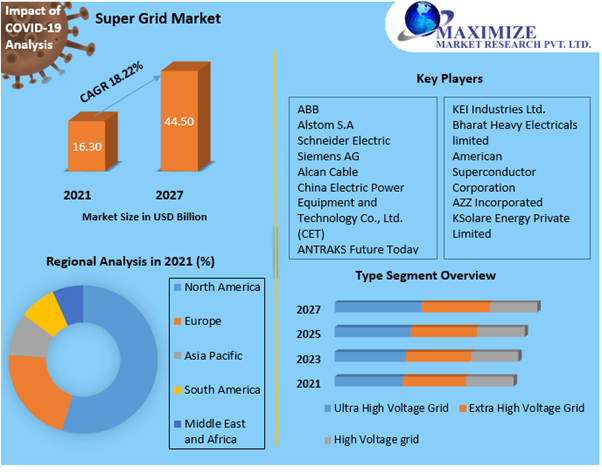
Super grids aren’t without their own flaws though! Apart from the regulatory and legal hurdles that are usually present while performing installations across international boundaries, investments into these projects can run into the millions, if not billions. Connecting millions of energy assets together is a daunting task and matching intercontinental demand with an equal amount of flexibility might just sound too ambitious. However, as is common with all facets of the energy transition, this might just be the solution that brings our world together for a common good.
Future Thought Leaders is a democratic space presenting the thoughts and opinions of rising Energy & Sustainability writers, their opinions do not necessarily represent those of illuminem.






